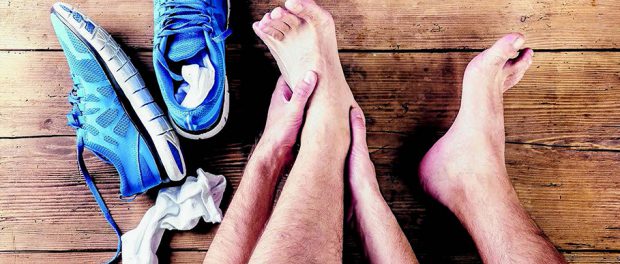LiveSmart: Plantar Fasciitis: Patience is the Key to Recovery

[This piece was written by Dave Steck, PT, MA, Cert. MDT with St. Peter’s Physical Therapy & Fitness.]
If you have a stabbing pain on the bottom part of your heel when you take your first step out of bed in the morning, you know about plantar fasciitis. The pain usually gets better once your foot gets limbered up, but it may return later in the day when you’re exercising; or maybe when you get up from your chair after a long period of sitting.
Plantar fasciitis involves a degenerative irritation of the fibrous band known as the plantar fascia that runs across the bottom of the foot, connecting the heel bone to the bones in the mid-foot and toes. Its function is to absorb shock while supporting the arch.
Excess demands of running, walking or load carrying, combined with weakness of the arch, can stretch and create small tears in the tissue. The irritated tissues tighten up during sleep, resulting in the pain felt on those first steps in the morning.
The condition is particularly common among runners, walkers and aerobic dancers who overdo it or try to rev up their training too fast. Other risk factors include being overweight, having either flat feet or a high arch, pronating (with feet rolling inward), having tight calf muscles and wearing shoes that are worn out or don’t fit well.
The first step: Stop doing whatever aggravates the pain and rest the heel. That does not mean to stop working out. You can swim, ride an exercise bike, or use a rowing machine or elliptical trainer. Ice the heel several times a day. Switch to shoes that are more suitable for your feet. And stretch regularly, focusing on the calf muscle and the Achilles tendon.
The stretching may be the most important part of your treatment. Do it before you get out of bed in the morning and several times during the day.
You can eventually get back to the activity that caused the irritation, but be careful at first and back off again at the first sign of discomfort. The rest gives you an opportunity to start cross training, which is the best long-term preventive strategy.
Some may need more comprehensive treatment in physical therapy such as taping (Kinesiotape) or custom orthotics. Some may benefit from a full foot and running sneaker assessment.
Ultimately, patience is the word. If you have enough patience and are willing to rest, ice and stretch your foot as prescribed, the pain will nearly always fade away.
St. Peter’s Physical Therapy & Fitness offers a full range of outpatient physical therapy services, including access to a state-of-the-art physical therapy gym and a Cardio Fitness Center, at 1240 New Scotland Road, Slingerlands, NY (approximately three miles from St. Peter’s Hospital). Services provided include kinesiotaping provided by a licensed practitioner; physical therapy; occupational therapy; speech therapies; and audiology. For information, please call 475-1818.







